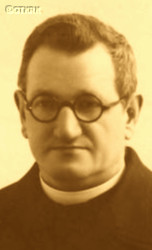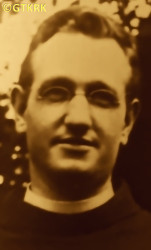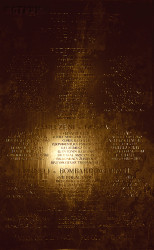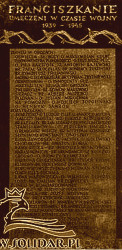Roman Catholic
St Sigismund parish
05-507 Słomczyn
85 Wiślana Str.
Konstancin deanery
Warsaw archdiocese, Poland
full list:
displayClick to display full list

searchClick to search full list by categories
wyświetlKliknij by wyświetlić pełną listę po polsku

szukajKliknij by przeszukać listę wg kategorii po polsku

Martyrology of the clergy — Poland
XX century (1914 – 1989)
personal data
religious status
Servant of God
surname
TOPOLIŃSKI
forename(s)
John (pl. Jan)
religious forename(s)
Adalbert (pl. Wojciech)
function
religious cleric
creed
Latin (Roman Catholic) Church RCmore on
en.wikipedia.org
[access: 2014.09.21]
congregation
Order of Friars Minor Conventual OFMConvmore on
en.wikipedia.org
[access: 2013.05.19]
(i.e. Conventual Franciscans)
diocese / province
st Anthony of Padua American province OFMConv
academic distinctions
Doctor of Theology
Doctor of Philosophy
honorary titles
Knight of Pontifical Benemerenti medal — Silver II Classmore on
en.wikipedia.org
[access: 2019.04.16]
date and place
of death
19.04.1940

Sztumtoday: Sztum gm., Sztum pov., Pomerania voiv., Poland
more on
en.wikipedia.org
[access: 2022.01.28]
alt. dates and places
of death
KL Stutthofconcentration camp
today: Sztutowo, Sztutowo gm., Nowy Dwór Gdański pov., Pomerania voiv., Poland
more on
en.wikipedia.org
[access: 2022.01.09]
details of death
In the summer of 1939 travelled to Poland in official capacity as canonization postulator on Abp Sapieha invitation.
Next he went to visit family, to Świecie, and his cousin in Gdynia.
After German and Russian invasion of Poland in 09.1939 and start of the World War II, after start of German occupation, arrested in 11.1939 by the Germans in Świecie — prob. as a witness to a massacre of Jews perpetrated by the Germans.
Transported to Bydgoszcz.
There all his money was appropriated.
After 24 hours — as USA citizen — released with proviso that he was obligated to go USA consulate in Gdańsk and get an exit visa (his visa in American passport has expired).
On 05.11.1939 went to Gdańsk.
On the way stopped for a night in Marianki n. Pieniążkowo.
Next day went to Gdańsk.
Met with local German secret political police Gestapo and was promised an exit visa to be collected on 10.11.1939, under condition that a written statement confirming that he was not a parish priest of Świecie parish would be submitted.
When returned to Marianki found out the local Gestapo looked up for him in the meantime.
On c. 08‐09.11.1939 got a required certificate from Gdańsk bishop.
On 10.11.1939 went to Gestapo offices.
Fate thereafter unknown.
alt. details of death
According to some sources murdered in KL Stutthof concentration camp.
According to others 4 weeks after disappearance Italian consulate that was looking for him received a reply from Germans that the lost one „went to General Governorate, nearby Kalisz, where a concentration camp was being opened” — Kalisz, however, was not included into Germ. Generalgouvernement (Eng. General Governorate) but into German Germ. Warthegau province and in vicinity there were no concentration camps.
Despite of this the assumption the he perished in German concentration camps is not without foundations.
cause of death
murder
perpetrators
Germans
sites and events
SztumClick to display the description, KL StutthofClick to display the description, GeneralgouvernementClick to display the description, «Intelligenzaktion»Click to display the description, Reichsgau Danzig‐WestpreußenClick to display the description, Ribbentrop‐MolotovClick to display the description, Pius XI's encyclicalsClick to display the description
date and place
of birth
23.04.1885

Papowo Biskupietoday: Papowo Biskupie gm., Chełmno pov., Kuyavia‐Pomerania voiv., Poland
more on
en.wikipedia.org
[access: 2021.12.18]
alt. dates and places
of birth
Świecietoday: Świecie gm., Świecie pov., Kuyavia‐Pomerania voiv., Poland
more on
en.wikipedia.org
[access: 2021.09.02]
religious vows
08.12.1904 (permanent)
presbyter (holy orders)
ordination
05.06.1909

Rometoday: Rome prov., Lazio reg., Italy
more on
en.wikipedia.org
[access: 2021.12.18]
positions held
1935 – 1940
general postulator — Rometoday: Rome prov., Lazio reg., Italy
more on
en.wikipedia.org
[access: 2021.12.18] ⋄ Conventual Franciscans OFMConv — i.a. postulator of the beatification of Queen Hedwig of Poland, Card. Stanislav Hozjusz, Fr Raphael Chyliński and Fr Clement Dydak, and the canonization of Bl. Kinga
1932 – 1939
professor — Rometoday: Rome prov., Lazio reg., Italy
more on
en.wikipedia.org
[access: 2021.12.18] ⋄ Department of Theology, St Bonaventure Bishop and Confessor „Seraphicum” [i.e. Pontifical Faculty of Theology (from 1955), Pontifical College (1935‐1955), College (till 1935)], Conventual Franciscans OFMConv — lecturer in Church history (1937‐1938), Greek language (1932‐1934), fundamental theology (1932‐1934); also: treasury officer / procurator (from 1932), librarian (from 1932)
1933 – 1939
apostolic penitentiary — Rometoday: Rome prov., Lazio reg., Italy
more on
en.wikipedia.org
[access: 2021.12.18] ⋄ St Peter the Apostle RC church (basilica)
from 1928
apostolic penitentiary — Loretotoday: Ancona prov., Marche reg., Italy
more on
en.wikipedia.org
[access: 2022.10.26] ⋄ RC church (basilica) — for English speaking penitents
1927
rector — Athol Springstoday: hamlet of Hamburg town, Erie Cou., New York US‐NY state, United States of America
more on
en.wikipedia.org
[access: 2022.10.26] ⋄ St Francis High School, Conventual Franciscans OFMConv
from 1926
secretary — St Anthony of Padua province (American), Conventual Franciscans OFMConv
from 1921
parish priest — Shamokintoday: Northumberland Cou., Pennsylvania US‐PA state, United States of America
more on
en.wikipedia.org
[access: 2022.10.26] ⋄ Conventual Franciscans OFMConv ⋄ St Stanislav Kostka the Confessor RC parish
1919 – 1920
parish priest — Lawrencetoday: Essex Cou., Massachusetts US‐MA state, United States of America
more on
en.wikipedia.org
[access: 2022.10.26] ⋄ Conventual Franciscans OFMConv ⋄ Holy Trinity RC parish
1911 – 1914
parish priest — Trentontoday: Mercer Cou., New Jersey US‐NJ state, United States of America
more on
en.wikipedia.org
[access: 2022.10.26] ⋄ Conventual Franciscans OFMConv ⋄ St Stanislav the Bishop and Martyr RC parish
vicar — Milwaukeetoday: Wisconsin US‐WI state, United States of America
more on
en.wikipedia.org
[access: 2022.10.26] ⋄ Conventual Franciscans OFMConv ⋄ St Josaphat RC parish
vicar — Buffallotoday: Erie Cou., New York US‐NY state, United States of America
more on
en.wikipedia.org
[access: 2022.10.26] ⋄ Conventual Franciscans OFMConv ⋄ Corpus Christi RC parish
till 1909
PhD student — Rometoday: Rome prov., Lazio reg., Italy
more on
en.wikipedia.org
[access: 2021.12.18] ⋄ philosophy and theology, St Bonaventure Bishop and Confessor „Seraphicum” [i.e. Pontifical Faculty of Theology (from 1955), Pontifical College (1935‐1955), College (till 1935)], Conventual Franciscans OFMConv
from 1903
student — Rometoday: Rome prov., Lazio reg., Italy
more on
en.wikipedia.org
[access: 2021.12.18] ⋄ philosophy and theology, St Bonaventure Bishop and Confessor „Seraphicum” [i.e. Pontifical Faculty of Theology (from 1955), Pontifical College (1935‐1955), College (till 1935)], Conventual Franciscans OFMConv
08.1903
accession — Conventual Franciscans OFMConv
15.10.1902 – 02.1903
pupil — Brothers Hospitallers OH — prob.
from 10.07.1902
pupil — Mostyskatoday: Mostyska urban hrom., Yavoriv rai., Lviv obl., Ukraine
more on
en.wikipedia.org
[access: 2020.11.20] ⋄ Redemptorists CSsR — prob.
23.07.1900 – 1902
pupil — Redemptorists CSsR — prob.
sites and events
descriptions
Sztum: Prison in Sztum was built in 1910‐1914, during the Prussian (German) partition of Poland. Initially, it had 450 cells that formed the letter 'T'. In the mid‐1930s — after World War I and the establishment of the Polish state, Sztum remained in Germany, in the West Prussian regency — another wing was added for 300 more prisoners, and the facility took the form of a cross. In 1939, just before the start of World War II, arrests of Polish activists began. Many passed through the Sztum prison before being sent to German concentration camps. During the war, the prison functioned normally. On 20.01.1945, in the face of the Russian offensive, the Germans began to evacuate the city and emptied the prison. After start of the Russian occupation, the Commie‐Nazis held in prison, among others Germans, soldiers of the Polish resistance Home Army AK — until 1953 the prison was overcrowded: 501 cells held up to 6,000 prisoners. (more on: pl.wikipedia.orgClick to attempt to display webpage
[access: 2014.11.28])
KL Stutthof: In German Germ. Konzentrationslager (Eng. concentration camp) KL Stutthof (then in Eastern Prussian belonging to Germany, today: Sztutowo village) concentration camp, that Germans started to build on 02.09.1939, a day after German invasion of Poland and start of the World War II, Germans held c. 110,000‐127,000 prisoners from 28 countries, including 49,000 women and children. C. 65,000 victims were murdered and exterminated. In the period of 25.01‐27.04.1945 in the face of approaching Russian army Germans evacuated the camp. When on 09.05.1945 Russians soldiers entered the camp only 100 prisoners were still there. In an initial period (1939‐1940) Polish Catholic priests from Pomerania were held captive there before being transported to KL Dachau concentration camp. Some of them were murdered in KL Stutthof or vicinity (for instance in Stegna forest). Also later some Catholic priests were held in KL Stutthof. (more on: stutthof.orgClick to attempt to display webpage
[access: 2018.11.18], en.wikipedia.orgClick to attempt to display webpage
[access: 2013.07.06])
Generalgouvernement: After the Polish defeat in the 09.1939 campaign, which was the result of the Ribbentrop‐Molotov Pact and constituted the first stage of World War II, and the beginning of German occupation in part of Poland (in the other, eastern part of Poland, the Russian occupation began), the Germans divided the occupied Polish territory into five main regions. In two of them new German provinces were created, two other were incorporated into other provinces. However, the fifth part was treated separately, and in a political sense it was supposed to recreate the German idea from 1915 (during World War I, after the defeat of the Russians in the Battle of Gorlice in 05.1915) of creating a Polish enclave within Germany. Illegal in the sense of international law, i.e. Hague Convention, and public law, managed by the Germans according to separate laws — especially established for the Polish Germ. Untermenschen (Eng. subhumans) — till the Russian offensive in 1945 it constituted part of the Germ. Großdeutschland (Eng. Greater Germany). Till 31.07.1940 formally called Germ. Generalgouvernement für die besetzten polnischen Gebiete (Eng. General Government for the occupied Polish lands) — later simply Germ. Generalgouvernement (Eng. General Governorate), as in the years 1915‐1918. From 07.1941, i.e. after the German attack on 22.06.1941 against the erstwhile ally, the Russians, it also included the Galicia district, i.e. the Polish pre‐war south‐eastern voivodeships. A special criminal law was enacted and applied to Poles and Jews, allowing for the arbitrary administration of the death penalty regardless of the age of the „perpetrator”, and sanctioning the use of collective responsibility. After the end of the military conflict of the World War UU, the government of the Germ. Generalgouvernement was recognized as a criminal organization, and its leader, governor Hans Frank, guilty of war crimes and crimes against humanity and executed. (more on: en.wikipedia.orgClick to attempt to display webpage
[access: 2024.12.13])
«Intelligenzaktion»: (Eng. „Action Intelligentsia”) — extermination program of Polish elites, mainly intelligentsia, executed by the Germans right from the start of the occupation in 09.1939 till around 05.1940, mainly on the lands directly incorporated into Germany but also in the so‐called Germ. Generalgouvernement (Eng. General Governorate) where it was called «AB‐aktion». During the first phase right after start of German occupation of Poland implemented as Germ. Unternehmen „Tannenberg” (Eng. „Tannenberg operation”) — plan based on proscription lists of Poles worked out by (Germ. Sonderfahndungsbuch Polen), regarded by Germans as specially dangerous to the German Reich. List contained names of c. 61,000 Poles. Altogether during this genocide Germans methodically murdered c. 50,000 teachers, priests, landowners, social and political activists and retired military. Further 50,000 were sent to concentration camps where most of them perished. (more on: en.wikipedia.orgClick to attempt to display webpage
[access: 2014.10.04])
Reichsgau Danzig‐Westpreußen: After the Polish defeat in the 09.1939 campaign, which was the result of the Ribbentrop‐Molotov Pact and constituted the first stage of World War II, and the beginning of German occupation in part of Poland (in the other, eastern part of Poland, the Russian occupation began), the Germans divided the occupied Polish territory into five main regions (and a few smaller). The largest one was transformed into Germ. Generalgouvernement (Eng. General Governorate), intended exclusively for Poles and Jews and constituting part of the so‐called Germ. Großdeutschland (Eng. Greater Germany). Two were added to existing German provinces. From two other separate new provinces were created. Vistula Pomerania region was one of them, incorporated into Germany on 08.10.1939, by decree of the German leader Adolf Hitler (formally came into force on 26.10.1939), and on 02.11.1939 transformed into the Germ. Reichsgau Danzig‐Westpreußen (Eng. Reich District of Gdańsk‐West Prussia) province, in which the law of the German state was to apply. The main axis of the policy of the new province, the territory of which the Germans recognized as the Germ. „Ursprünglich Deutsche” (Eng. „natively German”), despite the fact that 85% of its inhabitants were Poles, was Germ. „Entpolonisierung” (Eng. „Depolonisation”), i.e. forced Germanization. C. 60,000 Poles were murdered in 1939‐1940, as part of the Germ. „Intelligenzaktion”, i.e. extermination of Polish intelligentsia and ruling classes, in c. 432 places of mass executions — including c. 220 Polish Catholic priests. The same number were sent to German concentration camps, from where few returned (over 300 priests were arrested, of whom c. 130 died in concentration camps). C. 124,000‐170,000 were displaced, including c. 90,000 to the Germ. Generalgouvernement. Poles were forced en masse to sign the German nationality list, the Germ. Deutsche Volksliste DVL. Polish children could only learn in German. It was forbidden to use the Polish language during Catholic Holy Masses and during confession. Polish landed estates were confiscated..To further reduce the number of the Polish population, Poles were sent to forced labor deep inside Germany. The remaining Poles were treated as low‐skilled labor, isolated from the Germans and strictly controlled — legally, three or three of them could only meet together, even in their own apartments. Many were conscripted into the German Wehrmacht army. After the end of hostilities of World War II, the overseer of this province, the Germ. Reichsstatthalter (Eng. Reich Governor) and the Germ. Gauleiter (Eng. district head) of the German National Socialist Party, Albert Maria Forster, was executed. (more on: en.wikipedia.orgClick to attempt to display webpage
[access: 2024.06.24])
Ribbentrop‐Molotov: Genocidal Russian‐German alliance pact between Russian leader Joseph Stalin and German leader Adolf Hitler signed on 23.08.1939 in Moscow by respective foreign ministers, Mr. Vyacheslav Molotov for Russia and Joachim von Ribbentrop for Germany. The pact sanctioned and was the direct cause of joint Russian and German invasion of Poland and the outbreak of the World War II in 09.1939. In a political sense, the pact was an attempt to restore the status quo ante before 1914, with one exception, namely the „commercial” exchange of the so‐called „Kingdom of Poland”, which in 1914 was part of the Russian Empire, fore Eastern Galicia (today's western Ukraine), in 1914 belonging to the Austro‐Hungarian Empire. Galicia, including Lviv, was to be taken over by the Russians, the „Kingdom of Poland” — under the name of the General Governorate — Germany. The resultant „war was one of the greatest calamities and dramas of humanity in history, for two atheistic and anti‐Christian ideologies — national and international socialism — rejected God and His fifth Decalogue commandment: Thou shall not kill!” (Abp Stanislav Gądecki, 01.09.2019). The decisions taken — backed up by the betrayal of the formal allies of Poland, France and Germany, which on 12.09.1939, at a joint conference in Abbeville, decided not to provide aid to attacked Poland and not to take military action against Germany (a clear breach of treaty obligations with Poland) — were on 28.09.1939 slightly altered and made more precise when a treaty on „German‐Russian boundaries and friendship” was agreed by the same murderous signatories. One of its findings was establishment of spheres of influence in Central and Eastern Europe and in consequence IV partition of Poland. In one of its secret annexes agreed, that: „the Signatories will not tolerate on its respective territories any Polish propaganda that affects the territory of the other Side. On their respective territories they will suppress all such propaganda and inform each other of the measures taken to accomplish it”. The agreements resulted in a series of meeting between two genocidal organization representing both sides — German Gestapo and Russian NKVD when coordination of efforts to exterminate Polish intelligentsia and Polish leading classes (in Germany called «Intelligenzaktion», in Russia took the form of Katyń massacres) where discussed. Resulted in deaths of hundreds of thousands of Polish intelligentsia, including thousands of priests presented here, and tens of millions of ordinary people,. The results of this Russian‐German pact lasted till 1989 and are still in evidence even today. (more on: en.wikipedia.orgClick to attempt to display webpage
[access: 2015.09.30])
Pius XI's encyclicals: Facing the creation of two totalitarian systems in Europe, which seemed to compete with each other, though there were more similarities than contradictions between them, Pope Pius XI issued in 03.1937 (within 5 days) two encyclicals. In the „Mit brennender Sorge” (Eng. „With Burning Concern”) published on 14.03.1938, condemned the national socialism prevailing in Germany. The Pope wrote: „Whoever, following the old Germanic‐pre‐Christian beliefs, puts various impersonal fate in the place of a personal God, denies the wisdom of God and Providence […], whoever exalts earthly values: race or nation, or state, or state system, representatives of state power or other fundamental values of human society, […] and makes them the highest standard of all values, including religious ones, and idolizes them, this one […] is far from true faith in God and from a worldview corresponding to such faith”. On 19.03.1937, published „Divini Redemptoris” (Eng. „Divine Redeemer”), in which criticized Russian communism, dialectical materialism and the class struggle theory. The Pope wrote: „Communism deprives man of freedom, and therefore the spiritual basis of all life norms. It deprives the human person of all his dignity and any moral support with which he could resist the onslaught of blind passions […] This is the new gospel that Bolshevik and godless communism preaches as a message of salvation and redemption of humanity”… Pius XI demanded that the established human law be subjected to the natural law of God , recommended the implementation of the ideal of a Christian state and society, and called on Catholics to resist. Two years later, National Socialist Germany and Communist Russia came together and started World War II. (more on: www.vatican.vaClick to attempt to display webpage
[access: 2023.05.28], www.vatican.vaClick to attempt to display webpage
[access: 2023.05.28])
sources
personal:
www.bj.uj.edu.plClick to attempt to display webpage
[access: 2012.11.23], wpolityce.plClick to attempt to display webpage
[access: 2014.08.18], www.polonia.huClick to attempt to display webpage
[access: 2014.08.18]
bibliographical:
„Biographical–bibliographical dictionary of Polish Conventual Franciscan Fathers murdered and tragically dead in 1939‐1945”, Lukas Janecki, Franciscan Fathers’ Publishing House, Niepokalanów, 2016
original images:
www.audiovis.nac.gov.plClick to attempt to display webpage
[access: 2015.05.09], www.sowiniec.com.plClick to attempt to display webpage
[access: 2014.07.11]
LETTER to CUSTODIAN/ADMINISTRATOR
If you have an Email client on your communicator/computer — such as Mozilla Thunderbird, Windows Mail or Microsoft Outlook, described at WikipediaPatrz:
en.wikipedia.org, among others — try the link below, please:
LETTER to CUSTODIAN/ADMINISTRATORClick and try to call your own Email client
If however you do not run such a client or the above link is not active please send an email to the Custodian/Administrator using your account — in your customary email/correspondence engine — at the following address:

giving the following as the subject:
MARTYROLOGY: TOPOLIŃSKI John
To return to the biography press below:
 Click to return to biography
Click to return to biography












